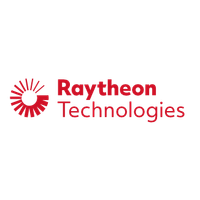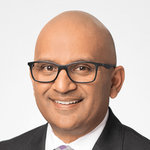
Raytheon Technologies Corp
NYSE:RTX

Raytheon Technologies Corp





In the bustling realm of aerospace and defense, Raytheon Technologies Corp. emerges as a formidable titan, sculpting the future of aviation and security. Born in 2020 from the merger of Raytheon Company and United Technologies Corporation, the company's roots dig deep into innovation, spanning decades of engineering prowess. Its operations are carefully categorized into four robust segments: Collins Aerospace, Pratt & Whitney, Raytheon Intelligence & Space, and Raytheon Missiles & Defense. Each segment functions akin to the gears of a finely tuned machine, collectively commandeering a monumental $64 billion revenue ship. With Collins Aerospace, Raytheon focuses on advanced avionics, interiors, and flight control systems, ensuring the skies are not just traversed, but mastered. Pratt & Whitney contributes with state-of-the-art engine technologies, propelling both commercial and military aircraft toward unprecedented performance benchmarks.
Meanwhile, Raytheon Intelligence & Space dedicates its energies towards satellite systems, cybersecurity, and high-tech radars, granting eyes and ears that pierce the veil of uncertainty and enhance global defense strategies. Raytheon Missiles & Defense adds muscle to the synergistic ensemble, creating sophisticated weapon systems and air defense solutions to counter evolving global threats. This blend of cutting-edge aerospace technology and advanced defense solutions positions Raytheon Technologies at the forefront of industrial symbiosis. By capitalizing on long-standing government contracts, strategic partnerships, and a continuous stream of innovations, Raytheon secures its forte in the market, building dreams not just of flight, but of fortified global security.
Earnings Calls
In Q4 2024, Mastech Digital reported revenues of $50.7 million, up 10.2% year-over-year. Notably, the Data and Analytics Services segment surged by 26.2% to $10.3 million. Despite a slight decline in IT Staffing consultant numbers, gross profit grew to $14.7 million, marking a 30% increase, with a record gross margin of 29%. GAAP net income turned positive at $0.3 million, compared to a loss of $5.4 million last year. For 2025, the focus will shift towards enhancing offerings and capitalizing on AI-driven opportunities, guided by a commitment to sustainable growth and profitability.
Management

Christopher T. Calio is an accomplished executive currently serving at Raytheon Technologies Corporation. He holds the prominent position of President and Chief Operating Officer (COO) at the company. In this role, Calio oversees the company's operations, focusing on driving strategic initiatives and ensuring that various business units align with corporate objectives. Before his current role, Calio was the President of Pratt & Whitney, a division of Raytheon Technologies focused on aircraft engines manufacturing and maintenance. Under his leadership, Pratt & Whitney expanded its product offerings and strengthened its position in the aerospace industry. Calio has a strong background in engineering and management, with experience leading complex projects and cultivating innovation within the aerospace sector. His career reflects a balance of technical knowledge and strategic leadership, contributing to Raytheon's growth and success in the global market. Throughout his tenure, he has been recognized for his ability to drive efficiency and manage large-scale operations, while fostering an environment of collaboration and innovation. Christopher T. Calio's contributions continue to be instrumental to Raytheon Technologies' prominence as a leader in the aerospace and defense industry.

Neil G. Mitchill Jr. is a prominent executive at Raytheon Technologies Corporation, a major aerospace and defense company. He serves as the Chief Financial Officer (CFO), a position in which he is responsible for overseeing the company's financial strategy, performance, and operations. His role involves managing financial planning, risk management, record-keeping, and financial reporting. Before his tenure at Raytheon Technologies, Mitchill made significant contributions to United Technologies Corporation (UTC), where he held various leadership roles, including Corporate Vice President of Financial Planning & Analysis and Investor Relations. His experience in finance and operations strategies contributed to the successful merger of UTC’s aerospace businesses with Raytheon Company in 2020, forming Raytheon Technologies. Neil G. Mitchill Jr. holds a Bachelor’s degree from Trinity College and a Master’s degree in Business Administration from the MIT Sloan School of Management. His extensive background in finance and strategic operations has made him a key leader in Raytheon Technologies' continued growth and financial health.

Robin L. Diamonte is a notable executive renowned for her work in strategic employee benefit programs. She is the Executive Vice President and Chief Investment Officer at Raytheon Technologies Corporation. Prior to her role at Raytheon, she served as the CIO of United Technologies Corporation (UTC) before its merger with Raytheon. Diamonte is highly respected for her expertise in managing and overseeing defined benefit and defined contribution plans. With a career spanning several decades, she has played a crucial role in managing large-scale pension funds and investment strategies. Diamonte is recognized for her innovative approach to managing corporate investments and her ability to navigate complex financial landscapes. Before joining UTC, she had an extensive tenure at Verizon, where she gained valuable experience in pension investment strategy and management. Diamonte holds a Bachelor of Science in Electrical Engineering from the University of New Haven and a Master of Business Administration in Finance from the University of Hartford. Her educational background and professional experience have equipped her with a unique blend of skills and insights, contributing significantly to her role at Raytheon Technologies, where she continues to drive the company’s investment strategies and policies.

As of the latest available information, Amy L. Johnson serves as the Chief Accounting Officer at Raytheon Technologies Corp. In this role, she is responsible for overseeing the accounting and financial reporting functions of the company. Johnson has a strong background in finance and accounting, with extensive experience in leadership positions within the aerospace and defense industry. Before joining Raytheon Technologies, she held various positions that contributed to her expertise in managing complex financial operations and ensuring regulatory compliance. Her leadership is instrumental in maintaining the company's financial integrity and supporting its strategic initiatives. Additionally, Amy L. Johnson's contributions to Raytheon Technologies play a significant part in enhancing shareholder value and driving the company's growth.

Juan M. de Bedout is a recognized leader in the aerospace and defense industry, particularly known for his contributions at Raytheon Technologies Corp. He is the Chief Technology Officer (CTO) of Raytheon Technologies' Collins Aerospace division. In this role, de Bedout is responsible for driving technological innovation and overseeing the development of advanced systems and solutions across various aerospace sectors. Before joining Collins Aerospace, he held several influential roles at United Technologies Corporation (UTC), where he made significant impacts through his leadership in technology and engineering. His expertise spans across several domains, including systems integration, project management, and product development, with a focus on enhancing aerospace capabilities. Juan M. de Bedout holds a deep educational background in engineering, providing him with the technical foundation to fuel innovation within the companies he has worked for. His leadership and visionary approach to technology have consistently propelled organizations towards achieving their strategic goals in the competitive aerospace and defense market.
Ms. Jennifer Reed serves as the Vice President of Global Public Policy at Raytheon Technologies Corp. In her role, she oversees the development and execution of the company's global public policy strategies, working to advance Raytheon's interests across various governmental and regulatory landscapes. With a focus on impactful advocacy, she plays a crucial role in shaping policies that support the defense and aerospace industry's growth and innovation. Before joining Raytheon Technologies, Ms. Reed held significant positions within the government and private sectors, bringing a wealth of experience in policy, legislative affairs, and strategic planning. Her career is marked by her ability to navigate complex regulatory environments and her commitment to fostering strong relationships with key stakeholders. Ms. Reed is recognized for her leadership and expertise in public policy, contributing significantly to the alignment of Raytheon's business objectives with global policy frameworks. She holds degrees in political science and international relations, which underpin her strategic approach to her work.

As of the latest available information, there is no detailed public biography or information on a Mr. Ramsaran Maharajh Jr. in connection with Raytheon Technologies Corp. It's possible that he may not hold a highly public-facing executive position within the company, or he might be a private individual not widely documented in publicly accessible sources. If you have more context or details, it might help refine the search for information. Otherwise, this might be a case where detailed public records or biographies are not available.

Pamela M. Erickson is a prominent executive known for her work at Raytheon Technologies Corp. She serves as the Vice President of Global Branding and Corporate Citizenship for the company. In this role, she is responsible for overseeing the global brand strategy and managing the corporation's reputation and stakeholder engagement. Erickson has been instrumental in leading initiatives that enhance Raytheon’s brand presence and drive corporate social responsibility programs. Erickson holds a bachelor's degree in communications and has a wealth of experience in corporate communications and brand management. Before joining Raytheon Technologies, she held various senior-level positions in marketing and communications across different industries, which contributed to her expertise in global branding and citizenship strategies. Under her leadership, Raytheon Technologies has strengthened its community engagement and sustainability efforts, reflecting the company’s commitment to innovation, inclusion, and positive societal impact. Her work ensures that Raytheon meets its strategic objectives while fostering a culture of responsibility and engagement within and outside the organization.

Dantaya M. Williams is an accomplished executive known for her extensive contributions to Raytheon Technologies Corp, where she has played a significant role in driving human capital strategies. As Chief Human Resources Officer (CHRO), she has been instrumental in overseeing the company's HR operations, focusing on talent development, diversity, equity, and inclusion, and organizational effectiveness. With a career spanning various leadership positions, Williams brings a wealth of experience in managing complex HR challenges and implementing strategies that align with the company's business objectives. Her leadership has been pivotal in fostering a corporate culture that emphasizes innovation, collaboration, and employee engagement. Williams is recognized for her strategic vision and commitment to nurturing a diverse and inclusive workforce, reflecting her influence within the aerospace and defense industry.

Shane G. Eddy is a prominent figure in the aerospace industry, currently serving as the President of Pratt & Whitney, a subsidiary of Raytheon Technologies Corp. Prior to assuming this role, Eddy has had a distinguished career in various leadership capacities. His extensive experience in the aerospace sector includes roles in operations, engineering, and manufacturing. Before joining Pratt & Whitney, Eddy was part of UTC Aerospace Systems and played a significant role at Sikorsky, another subsidiary, where he was instrumental in operations management and product development. Eddy's leadership is marked by a focus on innovation, operational excellence, and strategic growth. In his current position at Pratt & Whitney, Eddy oversees the development and production of aircraft engines and auxiliary power units, driving forward the company's commitment to sustainability and technological advancement, particularly in the realm of more efficient and environmentally friendly engines.





















































 You don't have any saved screeners yet
You don't have any saved screeners yet

Greetings, and welcome to the Mastech Digital Q4 2024 Earnings Call. [Operator Instructions] As a reminder, this conference is being recorded. It is now my pleasure to introduce your host, Jenna Lacey, Manager of Legal Affairs for Mastech Digital. Thank you, Ms. Lacey, you may begin.
Thank you, operator, and welcome to Mastech Digital's Fourth Quarter 2024 Conference Call. If you have not yet received a copy of our earnings announcement, it can be obtained from our website at www.mastechdigital.com. With me on the call today are Nirav Patel, Mastech Digital's Chief Executive Officer; and Jack Cronin, our Chief Financial Officer.
I would like to remind everyone that statements made during this call that are not historical facts are forward-looking statements. These forward-looking statements include our financial growth and liquidity projections as well as statements about our plans, strategies, intentions and beliefs concerning the business, cash flows, costs and the markets in which we operate. Without limiting the foregoing, the words believes, anticipates, plans, expects and similar expressions are intended to identify certain forward-looking statements. These statements are based on information currently available to us, and we assume no obligation to update these statements as circumstances change.
There are statements -- there are risks and uncertainties that could cause actual events to differ materially from these forward-looking statements including those listed in the company's 2023 annual report on Form 10-K filed with the Securities and Exchange Commission and available on its website at www.sec.gov.
Additionally, management has elected to provide certain non-GAAP financial measures to supplement our financial results presented on a GAAP basis. Specifically, we will provide non-GAAP net income and non-GAAP diluted earnings per share, which we believe will provide greater transparency with respect to the key metrics used by management in operating the business. Reconciliations of these non-GAAP financial measures to their comparable GAAP measures are included in our earnings announcement, which can be obtained from our website at www.mastechdigital.com. As a reminder, we will not be providing guidance during this call nor will we provide any guidance in any subsequent one-on-one meetings or calls.
I will now turn the call over to Nirav for his comments.
Thanks, Jenna, and good morning, everyone. Today is my 45th day with Mastech Digital, and it's a privilege to address you today as Mastech Digital's Chief Executive Officer. Let me start by giving you a bit of my background and experience. I have well over 25 years of experience as a technology executive with a track record of scaling large and midsized organizations. I have held several prominent leadership roles throughout my career. Prior to joining Mastech Digital, I served for over 4 years as President and CEO of Bristlecone, an AI-powered pure-play supply chain transformation company.
And before that, I spent over 19 years at Cognizant, playing many executive roles, scaling multibillion-dollar businesses across its key industry segments and serving enterprise clients globally. It's been an incredible and busy first 45 days since stepping into my role at Mastech Digital. I'm about halfway through my first 100 days. And in addition to focusing on the execution of our plans, I have spent a considerable amount of time listening to our customers, partners, employees and investors. It is important for me to hear their perspectives and understand the expectations they have of us for the future.
What is clear to me is that we have a strong foundation and culture that is deeply rooted in customer focus. But what's also clear to me is that we are at an inflection point, both in terms of speed of change brought by the AI revolution across our enterprise customers and the changing landscape of technology service providers in this rapidly evolving AI-first world. I believe that winning in the future will require organization like ours to have a sharper execution focus and the founder's mindset for unlocking growth. We cannot ignore the evolving landscape shaping our industry.
We are seeing the uncertainties created from a changing macro environment leading to greater caution and slower decision-making. Companies are carefully assessing interest rates, liquidity and market conditions to ensure their technology investments are both strategic and sustainable. That being said, I have no doubt that the AI revolution is real. Across industries, AI, automation and data-driven decision-making are no longer just concepts. They are being actively embraced and internalized. Organizations are moving beyond exploration, building proof of concepts, integrating AI into core processes and in many cases, rapidly scaling these capabilities to drive competitive advantage.
While the path forward may not be linear, the appetite for AI-driven solutions remains strong. Emerging AI models like OpenAI, Cloud, Lama and DeepSeek are reinforcing the fact that AI is reshaping how enterprises work, optimize and innovate. While Jack will provide a detailed update, I wanted to share a few thoughts on our performance in the fourth quarter of 2024.
We have made meaningful progress delivering revenue and margin growth with data and analytics seeing particularly strong acceleration. This performance reinforces our conviction that AI-driven digital modernization is the next frontier and that we are well positioned to capture this momentum.
I sum up the fourth quarter in 2 words: execution and transition. We believe that 2025 will be the year we begin our transformation, one that helps enterprises reimagine themselves and transition into AI-first organizations. This is just the beginning of that journey. Looking ahead, we believe our long-term success will be driven by 3 principles that define who we are and where we are going. First, we believe we must lead with a sense of urgency. The window to establish ourselves as a leading technology provider that helps enterprises reimagine and transform into AI enterprises will not stay open forever. In this space, speed is not just an advantage, it is the difference between leading and lagging.
Second, we believe we must build a compelling and relevant portfolio of offerings. Differentiation will be key. We are not just creating innovative solutions, but solutions that are essential to how businesses operate in the AI era. We believe our data modernization and staffing solutions must work together to drive deeper client engagement. It's not enough to participate. We believe we must integrate our strengths into a seamless high-value offering that sets us apart.
Third, we believe we must execute with discipline. Growth is only meaningful when it is sustainable and profitable. We intend to drive efficiency across the organization, operate with accountability and ensure that every investment we make and every position we take creates lasting value for our customers, employees and shareholders. I recognize that building confidence in the leadership takes time and that it must be earned through clear execution and transparency. My commitment to you is simple. I plan to be direct about where we are, clear about where we need to go and decisive about how we get there. Mastech Digital is not starting from scratch. We believe we have the right foundation, the right talent and the right market opportunity. What we need is the runway to refine our strategy, sharpen our execution and create a growth story that is truly our own.
Thank you for your time and trust. I will now hand it over to Jack.
Thanks, Nirav, and good morning, everyone. Our fourth quarter 2024 financial results reflected the positive momentum that we experienced over the last 9 months of 2024.
Consolidated revenues during the fourth quarter totaled $50.7 million, a year-over-year increase of 10.2% compared to the corresponding quarter of 2023. Our Data and Analytics Services segment reported revenues of $10.3 million in Q4 2024, which were 26.2% higher on a year-over-year basis and 9.4% sequentially higher than our revenue performance in the previous quarter. Order bookings in Q4 2024 totaled $11 million, which was somewhat below our expectations.
In the fourth quarter of 2024, our IT Staffing Services segment had revenues of $40.5 million, achieving year-over-year revenue growth of 6.8%. During the quarter, our billable consultant base declined by 63 consultants, which is generally in line with previous years due to seasonal high assignment ends. As expected, this will have some impact on our Q1 2025 revenue results.
Consolidated gross profit dollars totaled $14.7 million in Q4, which exceeded the corresponding quarter of 2023 by $3.4 million or a 30% increase, driven by higher revenue volumes as well as increasing gross margin percent. Our Q4 2024 gross margin percent was a company record 29% as both of our business segments had significant margin expansion from the previous year.
In our Data and Analytics Services segment, gross margins as a percent of revenue increased by 480 basis points to 49.5% in Q4 2024 compared to 44.7% in the fourth quarter of 2023. This increase reflected higher utilization and better project delivery.
In our IT Staffing Services segment, gross margins were up 350 basis points in Q4 compared to Q4 2023 due to an increase in direct hire revenues, a favorable medical claim experience in our self-insured health care program and higher margins on new assignments. GAAP net income for the fourth quarter of 2024 totaled $0.3 million or $0.02 per diluted share compared to a net loss of $5.4 million or a negative $0.46 per share in Q4 of 2023.
Non-GAAP net income for Q4 of '24 was $2.8 million or $0.23 per diluted share compared to $1.3 million or $0.11 per diluted share in the '23 fourth quarter. SG&A expense items not included in non-GAAP financial measures, net of tax benefits are detailed in our fourth quarter earnings release for all periods presented and are available on our website.
Highlights of our full year 2024 results included the following: 2024 revenues were $198.9 million, which was largely in line with our full year 2023 revenues. Gross margins in '24 totaled 27.9% compared to 25.4% in 2023. Our Data and Analytics Services gross margin percent increased by 560 basis points on a year-over-year basis. And in our IT Staffing Services segment, our gross margin percent increased by 160 basis points.
GAAP diluted earnings per share in 2024 was a profit of $0.28 versus a loss of $0.61 in 2023. Non-GAAP diluted earnings per share in '24 totaled a profit of $0.71 compared to a profit of $0.44 in 2023, an increase -- an improvement of 61%.
At December 31, 2024, our liquidity and overall financial position remains solid. Today, we have no bank debt outstanding. We have $27.7 million of cash balances on hand. We have cash availability of $22.6 million under our revolving credit facility and our days sales outstanding measurement at December 31, 2024, totaled 52 days, which was well within our targeted range.
Devin, that completes our prepared comments. We'd like to open it up for questions now.
[Operator Instructions] Our first question comes from the line of Lisa Thompson with Zacks Investment Research.
We're all looking forward to an exciting 2025. I know there's a lot of possibilities out there. Could you talk a little bit about what your thinking is of how you're going to approach increasing staffing and D&A? Is there going to be any strategy changes besides the obvious of trying to incorporate AI into your whole service offerings? How is that going to work?
Sure, Lisa. Thank you for the question. Nirav here. I'll take that one. Look, I'm taking a very, very structured approach, Lisa, to defining our long-term strategy. And I sort of -- I've just stepped into my role and my immediate priority is to deeply learn about our business and engage with our teams, customers and partners, and to really have a chance to assess our starting point in terms of our challenges and opportunities.
What I can say with confidence that Mastech has a very, very strong foundation. Our focus will be on accelerating growth, driving excellence and enhancing our offerings. But I am going to take a little bit of a structured approach in defining this strategy, and I look forward to be sharing more specific details sometime later half of this year as we refine our plans and execution road map.
Okay. I'm also curious that there's a lot of talk about government efficiency now. Do you see any opportunities in there? If there ever is an entity that needs data modernization, I think that would be the one.
Clearly, government opportunities are something that -- especially in D&A that we look at for sure. So I guess the answer to your question is, yes.
Okay. All right. Could you do happen to have offhand how many employees you ended the year with?
Yes, I do. We ended the year with total employees of both segments 1,816. And just as a point of reference, last year, we had -- we ended the year 2023 with 1,648.
Okay. So that's a pretty big increase.
Yes, not bad.
All right. Yes, yes. And do you have any thoughts about spending this year? Is it going to be pretty much steady? Or is there any investment you need to do?
Spending like on SG&A cost or spending on CapEx?
Well, either, but mostly SG&A.
Okay. SG&A, yes, our objective in SG&A is to continue to maintain our SG&A expense at the same percentage that we had in 2024 for 2025. So that's the objective. And it's going to be a little bit by quarter-to-quarter. I would say that probably in the first half of 2025, we're going to probably not reach that goal because I think we are going to be hiring some of the missing pieces related to a new growth strategy. But by the end of the year, with what we believe would be increases in revenue as well as maybe some cost savings initiatives, we should come in at that objective.
And from a CapEx standpoint, we don't have a whole lot of capital expenditures. I mean we're -- maybe it's certainly under $1 million. So that will still hold, clearly under $1 million.
Okay. And you're still thinking 28% tax rate?
Well, the 28% tax rate, it encompasses like a 123R expense true-up based on the gains that our employees enjoy from exercising their shares versus the company expense related to those shares. So in the last year -- well, let's say, the last 1.5 years, our true-up was negative, which negatively impacts the tax rate. That's why we were 28%. In fourth quarter, our stock price was a little bit higher and a lot of the exercises came in at gains that were greater than the 123R expense, the compensation expense. And actually, our tax rate was actually lower than 25%. So a lot of that depends on some of these unusual true-ups that we have to make from a tax perspective.
Our next question comes from the line of Marc Riddick with Sidoti & Company.
I wanted to touch a little bit on some of the commentary around the bookings during the quarter. And maybe if you could spend maybe a little bit of time sort of giving us a picture on sort of how that progressed, either whether it was -- whether by monthly or were there changes in the demand pre post election? Was -- did the bookings look different based on client verticals? Anything that you could sort of share there as to maybe what you were seeing during the fourth quarter? And then maybe any thoughts as to maybe how the year has begun as far as client activity would be really helpful.
Sure, Marc. I'll take a stab at that. When we looked at our pipeline at the beginning of Q4 and looking at our pipeline, we had a range of where we thought we would land in total bookings and the $11 million came short of that. And we had some project delays because there is a little bit, in particular, in D&A, there's a little bit of uncertainty in the marketplace. I mean we saw a few clients where we thought they were going to give us bookings in Q4, and they delayed those.
And so there is -- we clearly see some uncertainty in the marketplace. What's the driver of that uncertainty? I mean, we can guess, is it a tick up in inflation? Is it political concerns, unknowns. But whatever the reason, our clients seem to be less eager to give booking deals immediately. They seem to have a longer cycle -- sales cycle on that before they let a booking transpire.
Okay. And is there -- and I know this is a bit granular, but I was just sort of curious, is there anywhere in particular, whether it's certain types of clients? Or do you think that's sort of more of an across-the-board kind of situation right now?
I would say across the board. I would say across the board. I mean we have some bookings on financial service clients. We've had Q4 bookings on health care clients. It's just that we didn't get the amount that we expected given the robust pipeline that we had.
Okay. And then one of the things I did want to highlight it in your -- in the press release was around the extension of the share repurchase program, which was initially scheduled to end earlier this month and has now been extended to February of '26. Just wondered if you could share any thoughts there. I can understand that, Nirav, you've been there for like 45 days. I can understand that you get to have some time to sort of work through some of the prioritizations. But I was just sort of wondering if you could share any thoughts on that share repurchase extension there.
Yes. I mean the Board made that decision, right? And we had this program for 2 years prior. And during that 2-year period, we experienced a number of extended blackout periods where we weren't able to repurchase our shares. They were like corporate-related transactions and events. we think most of that is behind us, and we have 423,000 shares remaining in the share buyback program, we would like to capitalize on some of those. So I do think that you're going to see less blackout periods and more buyout volume in 2025 compared to last year.
Great. And then the last thing for me as far as potential uses of cash, obviously, a very strong balance sheet to work with at the moment. I was wondering if you could talk about any thoughts on potential acquisitions and maybe what that pipeline may look like now, whether valuations have changed in the last few months or we've seen a few small deals in the space, but maybe sort of comment on maybe what you're seeing out there.
Sure, Marc. This is Nirav here. I'll take that first. So Marc, I think, look, like I said that we are certainly in the phase where we are sort of starting to think through our go-forward strategy, and we are sort of trying to really get a little bit more clarity on that. And I think like I said earlier, right, I just stepped in on my role. And in terms of my go-forward strategy, my immediate priority is really to listen and learn.
And I think I am taking a fairly structured approach of thinking through our long-term approach strategy, which kind of will include elements of organic and inorganic plays and so forth. But to me, I think we're getting the direction for the company in terms of where we are headed lays an important emphasis before we would sort of activate or execute on any of those transactions. But please feel free to chime in, Jack, if you want to share your thoughts.
The only thing that I would say, Marc, is M&A is part of our growth strategy for sure. It always has been. It's just that when you're changing leadership, it's hard to decide exactly what you want to purchase. So I think Nirav...
No, that's...
I think once in a year...Go ahead, Marc?
No, I was just going to say we're certainly looking forward to working with you going forward and looking forward to your vision for the company going forward. And that's about it for me today.
Thank you, Marc. I'm equally excited and looking forward to working with you.
[Operator Instructions] There appear to be no further questions at this time. I'd like to turn the floor back over to Mr. Patel for closing remarks.
Thank you, Devin. If there are no additional questions, I thank you for your time, and I look forward to talking with you in early May for our Q1 2025 earnings call.
This concludes today's teleconference. You may disconnect your lines at this time. Thank you for your participation, and have a wonderful day.